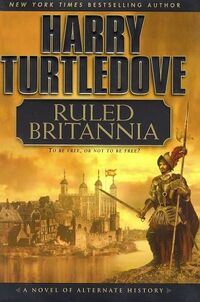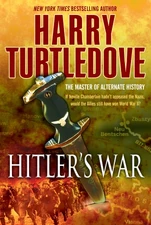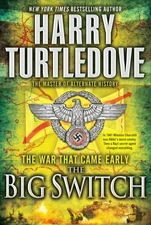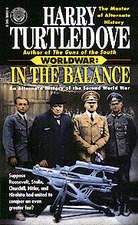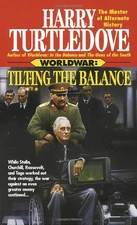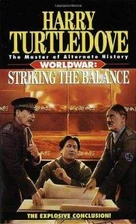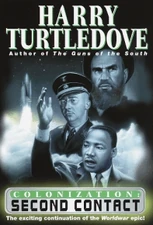| Kingdom of Denmark | |
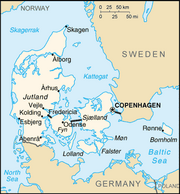
| |
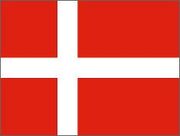
| |
| Country | |
| Continent: | Europe |
| Capital: | Copenhagen |
| National Language: | Danish |
| Government: | Unitary parliamentary constitutional monarchy |
| Status in OTL: | Active |
Denmark is a Scandinavian country in Northern Europe and the senior member of the Kingdom of Denmark. It is the southernmost of the Nordic countries, southwest of Sweden and south of Norway, and bordered to the south by Germany. Denmark borders both the Baltic and the North Sea. The country consists of a large peninsula and many islands. Copenhagen is the capital.
Denmark is a constitutional monarchy with a parliamentary system of government. Denmark has a state-level government and local governments in 98 municipalities. Denmark has been a member of the European Union since 1973, although it has not joined the Eurozone. Denmark is a founding member of NATO and the OECD.
Denmark in "Drang von Osten"[]
Denmark joined the German-led coalition to meet China's invasion of Russia in 2041. While the coalition was initially successful in meeting the invasion in European Russia, by 2043, the coalition's lines were collapsing, and Chinese troops were making their way into Ukraine.[1]
Denmark in The Hot War[]
Denmark was a member of NATO when World War III broke out in 1951. For most of the war, Denmark played a supporting role, housing U.S. airbases and radar stations. It did not send troops into the actual fighting.[2]
In October 1951, a Soviet Tu-4 piloted by Boris Gribkov was able to safely cross the Danish Peninsula on its way to drop an atomic bomb on Antwerp, Belgium.[3]
Denmark in In the Presence of Mine Enemies[]
Denmark was annexed into the Greater German Reich after its defeat in the Second World War in 1940. Since the Danes were considered Aryan by the Nazis, they afforded better treatment than countries like Poland, Serbia, Russia and the Ukraine.
With the death of Führer Kurt Haldweim and his replacement with reformer Heinz Buckliger in 2010, the Danes began demanding independence. In 2011, two men were arrested in Copenhagen for carrying an anti-German poster through the streets demanding full independence for Denmark.
The government of Denmark was among those that denounced the SS' attempted Putsch in Germany.
Denmark in "The Old Grind"[]
Rollo's Vikings returned home to Denmark after pillaging England, to replenish their supplies for the incursion into Francia. Fenia the giantess did not like her experience in Denmark. While the Vikings accepted her, the women and children either feared her or threw rotten fruit at her.
Denmark in Ruled Britannia[]
Denmark, a Protestant nation in Europe, was ruled by King Christian IV. Following the conquest of England, and the installation of a Spanish-backed Catholic regime in 1588, many dissatisfied English Protestants took refuge in Denmark. Other exiles escaped there for their own reasons, including Anthony Bacon and his young lover Tom, who found that the Danes were more willing than the Spanish to turn a blind eye to "sodomite" activities. Baltasar Guzmán believed Spain should send an army to conquer Denmark and restore Catholicism to it as it had England and the Netherlands.
The old Danish legend of Amleth was Wiliam Shakespeare's inspiration for writing Prince of Denmark.
Denmark in Southern Victory[]
Denmark remained neutral during the Great War. However, after the war, the nation went under German influence. Denmark became a member of the Central Powers during the Second Great War. Physicist Niels Bohr joined Germany's superbomb effort.
Denmark in The Two Georges[]
In the late 20th century, Denmark maintained a modest empire in Scandinavia, controlling Norway, Greenland, and Iceland.[4]
Denmark in The War That Came Early[]
Denmark had not taken part in a war for more than 70 years when a broad European conflict broke out on 30 September 1938. Naturally, Denmark proclaimed neutrality one more time and remained confident that the belligerents would respect it, an attitude that continued even after Germany invaded the neutral nations of the Netherlands, Belgium and Luxembourg one month later, sunk the also neutral American liner SS Athenia on her route to Copenhagen in January 1939 (though German propaganda denied responsibility of the event) and made things difficult for civilians from non-belligerent countries that were trapped in the Reich such as Peggy Druce to escape to Denmark.
Germany finally invaded Denmark in Summer 1939, primarily to use a springboard for the invasion of Norway. As the Danish Army wasn't even mobilized, the country was easily overrun, with German ships sailing unopposed all the way to Copenhagen's port and landing troops right next to Amalienborg Palace, the residence of King Christian X. Some Danish civilians at first thought that they were watching the filming of some movie rather than an actual invasion.
Denmark's occupation was unusually kind, as neither the Danish government nor the King were formally forced to cede any power. The Germans claimed that the country was fully independent and that their forces were there to protect Denmark against aggression from Britain and France, with German military governor Leonard Kaupitsch even refusing to hang the Nazi flag on his headquarters as to not anger the Danish.
Although soft, most Danish civilians still disliked the occupation. They also considered it shameful that there were enough pro-fascists in their country to form the collaborationist Frikorps Danmark.[5]
Denmark remained under German control until 1944, when Adolf Hitler was assassinated by the Committee for the Salvation of the German Nation in April of that year.[6] After the Nazi Party was completely removed from power, Germany withdrew from Denmark.[7]
Denmark in Worldwar[]
Denmark was invaded and conquered by Germany at the beginning of World War II and absorbed into the Greater German Reich. Its colonies of Iceland and Greenland were occupied by the Allied Forces and eventually were taken over by joint American-Canadian administrators under the terms of the Peace of Cairo in 1944. During the war against the Race's Conquest Fleet, Joachim von Ribbentrop sometimes sailed in ships flying the Danish flag on the rationale that such ships would make less tempting targets to the Race's pilots than German ships.
Denmark's capital, Copenhagen, was destroyed by a Race explosive-metal bomb in 1944.
See also[]
- Denmark at the Leviathans wiki.
References[]
- ↑ See, e.g., We Install and Other Stories, loc. 417-820.
- ↑ Fallout, loc. 3139, ebook.
- ↑ Ibid., loc. 3143-3167.
- ↑ The Two Georges map. Denmark is not relevant to the actual plot of the novel.
- ↑ West and East, pg. 321, tpb.
- ↑ Last Orders, pgs. 300, HC.
- ↑ Ibid, pg. 318.




